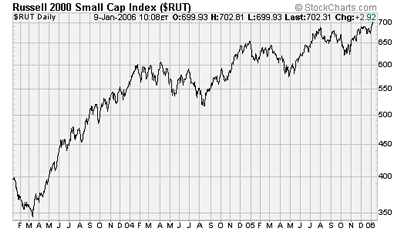| Home | About Us | Resources | Archive | Free Reports | Market Window |
It’s a Scavenger’s MarketBy
Tuesday, January 10, 2006
In last Friday’s column, I wrote about the filthy activity of dumpster diving. I called it “the perfect model for an investment strategy.” In today’s issue, we’ll look at a real world example of a dumpster investment you can make some serious money in. This weekend, I rifled through the archives at the National Hurricane Center. From whatever angle you look at it – cost, death, intensity, frequency – 2004 and 2005 is the most severe two-year period of hurricane activity since records began in 1841. As a result: Stock prices of catastrophe insurance companies have collapsed. Some of the stocks I follow are down as much as 50%. Companies with insurance exposure to hurricanes are among the most unpopular stocks on Wall Street. At the same time, there are two very strong reasons to be bullish on the stock prices of catastrophe insurance companies. On the demand side, everyone wants insurance. They’re scared that hurricane activity in 2006 and 2007 will be as extreme as it was 2004 and 2005. They will pay premium prices and high deductibles for coverage. On the supply side, catastrophe insurance is an unfashionable business. There’s little competition in the industry, so prices are high and margins are wide. If 2006 is a costly year in terms of hurricane damage, we’ll break even. The insurers have already covered their exposure by selling expensive policies with high deductibles. Besides, stock prices already expect the worst. But if hurricane activity reverts back to normal – and I bet it will – catastrophe insurers will keep all the profits. Steve and I always look for investments using the same framework... they have to be cheap, so the downside risk is limited. The position has to have enormous upside potential ... a spark to ignite the price. And we don’t want to compete with others to enter the trade. These are the investments found at the bottom of dumpsters, where no one else is looking. If you are prepared to do something that no one else is, you’ll be handsomely rewarded. It’s why I keep writing about dumpster diving. Dumpster diving is the perfect model for a contrarian investment strategy. Here’s an example: In the USA, the quantity and quality of loot in dumpsters is high. America is the most wasteful society ever. People can afford to throw away perfectly good stuff. At the same time, Americans are obsessed with germs, cleanliness and fear of looking poor - so there is little competition in the market from new scavengers. In other word’s, it’s a scavengers’ market. I guarantee it... if you have the nerve to poke around in the dumpster behind your local Wal-Mart tonight, you will be rewarded. The same “trade” wouldn’t work in Mexico. The attitude is totally different there... poverty is greater, so people waste less and scavenge more. You could say margins in the Mexican dumpster diving business are thinner. I’ve even come across entrepreneurial Mexicans who cross the border to just scavenge in American dumpsters north of the border. They sell the loot in local flea markets back in Mexico. Right now, it’s a scavengers’ market in the catastrophe insurance sector. There’s hardly any risk – even if we see one of the worst hurricane seasons on record – the insurance companies are covered. Yet there’s potential for a powerful rise in stock prices if hurricane activity reverts back to normal. Problem is... like those dumpster divers, the opportunity is only there for contrarian investors with the nerve to hold insurance companies through a hurricane season. Have you got it? Good Investing, Tom Dyson Market NotesTHE BULL MARKET IN SMALL STOCKS CONTINUES With gains of 82% since the beginning of 2003, small cap companies (as measured by the Russell 2000) have clobbered their large cap competitors. The large cap benchmark S&P 500 is up 46% in the same time. Last week’s all-time high of 700 in the Russell 2000 shows the long rally in small stocks is still going. Below is look at the big run in small stocks that began in 2003:
Although small caps are powering higher, their outperformance of large caps is beginning to stall. Both the S&P 500 and the Russell 2000 gained about 3% in 2005. |
Recent Articles
|


